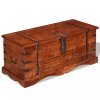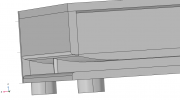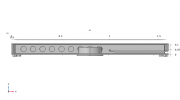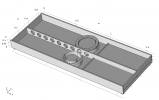Did you use a measurement or even a sub crawl to determine ideal placement or just went with what was "available"?Yes, that was also something I considered. As I mentioned I placed two subs at various spots behind the 2 channel speaker towers, which put them on either side of my center channel, (with the L/R home theater speakers flanking the subs). I also tried other positions but not for long.
Also had one sub in that position, another behind my sofa for a while.
(BTW, at one point I tried integrating only the single sub behind my sofa. I was actually quite impressed how well it integrated, all things considered).
-
WANTED: Happy members who like to discuss audio and other topics related to our interest. Desire to learn and share knowledge of science required. There are many reviews of audio hardware and expert members to help answer your questions. Click here to have your audio equipment measured for free!
You are using an out of date browser. It may not display this or other websites correctly.
You should upgrade or use an alternative browser.
You should upgrade or use an alternative browser.
What do floor standers really bring to the table?
- Thread starter Destination: Moon
- Start date
DanielT
Major Contributor
Who in the full use of their senses thinks that one (or more) black large ugly cube is aesthetically pleasing to have in their living / listening room?.... since I hate subwoofers - the looks, the added cabling and complexity, the hassle etc. Frankly selling it all off was a relief, aesthetically and financially.
It was overblown and bloated too. Like really obnoxious.
For the entire time I had those subwoofers in the room (a long time) bass was more bloated from the home theater system.
If it is possible to solve in terms of location, try to hide the sub, behind furniture, under furniture, cover them. Or build a sub of furniture that appeals to the personal interior design style, see picture
(just an example, you understand the point). If it is possible to place it sensible in the listening room, that is.
Regarding integrating sub with other speakers. I read on another forum about a person who experienced basically what you write. In the end, he hired a professional acoustician. Best money he ever spent on Hifi, was his comment.
Edit:
Based on own experience. You have to be a man. Solve it yourself. A good man manages himself and all that. I can be stubborn like a red pig. Fixing my car, for example, despite limited knowledge (plenty of limitations regarding self-insight also). It ends with the fact that I state that it would have been smarter to hire a professional car mechanic from the beginning. Please note I'm not talking about you now MattHopper.
Attachments
Last edited:
DanielT
Major Contributor
Double post. See my post above.
killdozzer
Major Contributor
When you say you enjoyed transients, what do you really mean?I went through the same phase as well, enjoying the transients of my 8inch in my bookshelfs. I suspect that the perhaps the slow roll off and lack of longer wavelengths does provide a percieved improvement in sound(without subs). But once you add powerful subwoofers with drivers that can keep up with intense bass and time align them with minumim 3 subs then its a different ballgame.
My phase was due to my dual subs being entry level and light cabinets and not yet able to perfect my DSP.
I think my point is that, I understand that feeling of how adding subs distorts(whichever way it does for your application) the mains and you don't end up getting what your after. I had that for years it is a difficult stumbling block and if your mains can give you enough bass than striving for subs to integrate well is a big effort like you said. Im one of those who spent years trying to perfect it and ultimately achieved it.
Ultrasonic
Addicted to Fun and Learning
A well-constructed ported speaker beats a sealed one every day of the week. Tighter bass, less distortion, more "nice hifi". There are only benefits. As I see it. Note: A well constructed.
I'm a little surprised about your 'tighter bass' comment there, as I would have thought most would actually pitch that as an advantage of sealed designs? In subwoofer terms it is also much more common to find people pushing sealed designs as being better for music ('more hifi'), although like most things this does get debated
It's tricky to unpick differences in terms of frequency response (bass extension / different low frequency roll-off) vs specifically differences related to sealed vs ported. I did try to do this once when comparing a sealed and ported sub, where I used EQ to match the frequency response very closely, and made sure they were level matched too of course. The difference wasn't as large as is often portrayed, but between the two I would definitely have described the sealed model as tighter. Here's where I posted the full details at the time (including measured data): https://www.avforums.com/threads/po...ry-of-mojogoes.1953630/page-168#post-27814740
killdozzer
Major Contributor
Good call. The bookshelf is sealed design and the floorstander is ported. Which may once again prove them to be the wrong example for focusing on one sole difference.is that a ported design?
Ultrasonic
Addicted to Fun and Learning
This is a rather strange comparison since you are comparing models from different ranges. There is a Kanta 1 standmount that is cheaper than the Kanta 3 floorstanding model, just as there is a Utopia floorstanding model that is much more expensive than the standmount mentioned.Focal must be pretty confident that the bookshelf Utopia is the better sounding of the 2,if they're selling the small Utopia for more $$$ than the much bigger and multiple drivers Kanta 3View attachment 160009View attachment 160010
killdozzer
Major Contributor
Sure. And many companies have examples such as this one. Price differences often refer to prices of driver development and time and expertise invested in XO development. Then there's materials and aesthetics. Still, in the end, it wouldn't be unimaginable one might find a person who prefers the cheaper Kanta. Such a person we usually refer to as a happy person. (Funny thing is, in my language kanta means bucket and is often used to describe a low quality product, such as a kanta of a car, or a kanta of a guitar, house, TT, CD player or just about anything, so Kanta of a speaker will get a laugh or two.)This is a rather strange comparison since you are comparing models from different ranges. There is a Kanta 1 standmount that is cheaper than the Kanta 3 floorstanding model, just as there is a Utopia floorstanding model that is much more expensive than the standmount mentioned.
DanielT
Major Contributor
I will read your link. What is tight? The parameters that determine the sound are frequency response and level of ditorsion (and scattering of sound). As for the sub, I read what a technical consultant in acoustics wrote:I'm a little surprised about your 'tighter bass' comment there, as I would have thought most would actually pitch that as an advantage of sealed designs? In subwoofer terms it is also much more common to find people pushing sealed designs as being better for music ('more hifi'), although like most things this does get debated. Where ported designs have a clear advantage I thought was efficiency and therefore usually peak output capability.
It's tricky to unpick differences in terms of frequency response (bass extension / different low frequency roll-off) vs specifically differences related to sealed vs ported. I did try to do this once when comparing a sealed and ported sub, where I used EQ to match the frequency response very closely, and made sure they were level matched too of course. The difference wasn't as large as is often portrayed, but between the two I would definitely have described the sealed model as tighter. Here's where I posted the full details at the time (including measured data): https://www.avforums.com/threads/po...ry-of-mojogoes.1953630/page-168#post-27814740
A well-implemented bass reflex solution is simply the best choice in almost all contexts. For a given cavity volume, a significantly lower lower cut-off frequency is obtained and also up to 10 times lower distortion at slightly higher sound pressure levels. It is not uncommon for 30% THD for a closed solution at low frequencies and medium sound pressure levels to be reduced to 3% with a bass reflex solution (of course only around the tuning frequency)
As for the allowable internal sound pressure, it is quite simple because the distortion is approximately proportional to the relative volume change, i.e. if you pump e.g. rather violent 5 liters as a peak value (approximately corresponding to 10 capable 12 "elements) in a 50 liter cavity, the air distortion becomes 10%, i.e. reasonably comparable to the distortion from the elements under heavy load.
This is thus seldom a practical problem, however, it takes a lot of power to overcome the high stiffness of the air spring so that you can actually move the cone and pump air in the closed case. In the bass reflex case, for the same reason, the efficiency of the Helmholtz resonance is lost when the cavity volume decreases. Herein lies the practical limitation.
DanielT
Major Contributor
It was not meant to be condescending. Mostly a general reflection regarding that if you have a problem, or challenge, you have to think of solutions.What are you an idiot?
dasdoing
Major Contributor
I'm a little surprised about your 'tighter bass' comment there, as I would have thought most would actually pitch that as an advantage of sealed designs? In subwoofer terms it is also much more common to find people pushing sealed designs as being better for music ('more hifi'), although like most things this does get debated. Where ported designs have a clear advantage I thought was efficiency and therefore usually peak output capability.
It's tricky to unpick differences in terms of frequency response (bass extension / different low frequency roll-off) vs specifically differences related to sealed vs ported. I did try to do this once when comparing a sealed and ported sub, where I used EQ to match the frequency response very closely, and made sure they were level matched too of course. The difference wasn't as large as is often portrayed, but between the two I would definitely have described the sealed model as tighter. Here's where I posted the full details at the time (including measured data): https://www.avforums.com/threads/po...ry-of-mojogoes.1953630/page-168#post-27814740
here is an SVS sub compared in sealed and ported mode: https://www.audioholics.com/subwoofer-reviews/svs-pb13/pb13-measurements
ported has 2 problems:
- more group delay
- ringing around the tuning frequency
if you hear that depends on the material being reproduced. with movies, electronic music and "audiophile" music you probably never notice it. percussive music will have a more natural "punch" though:
Good call. The bookshelf is sealed design and the floorstander is ported. Which may once again prove them to be the wrong example for focusing on one sole difference.
so the main diference is a gigantic port in the floor versions. how much more LF extension is pure addition of volume capable of?
DanielT
Major Contributor
you should specify that the difference of GD is in an area where the audibility is more than doubtful :10-20Hzhere is an SVS sub compared in sealed and ported mode: https://www.audioholics.com/subwoofer-reviews/svs-pb13/pb13-measurements
ported has 2 problems:
- more group delay
- ringing around the tuning frequency
if you hear that depends on the material being reproduced. with movies, electronic music and "audiophile" music you probably never notice it. percussive music will have a more natural "punch" though:
so the main diference is a gigantic port in the floor versions. how much more LF extension is pure addition of volume capable of?
dasdoing
Major Contributor
you should specify that the difference of GD is in an area where the audibility is more than doubtful :10-20Hz
well. that is true in the case of the SVS sub. a ported main speaker will have the tuning frequency higher
Galliardist
Major Contributor
I don't feel the need for 18 inch subs at all, I don't need home theatre and I don't feel that that kind of low response is needed for any of the music I listen to. That part of my comment was meant to be ironic. Yes, I would like larger accommodation and maybe a dedicated room, but we don't have that kind of money and I have to live with reasonable public transport to where I work.Money is not a problem
House costs
Personal constraints
Sounds like a riddle to solve. In any case, so uh something ...
I see you're talking about lack of space. If you do not have space, you do not have space. Then you have to adapt your mouth to the food bag.
If now it is so important to have a lot of 18 "sub, then you may well move to new accommodation where there is space. I solved the mystery!
I've made my choices according to my circumstances and it's all OK.
killdozzer
Major Contributor
Well, we might wright it of as a bad communication. It sure sounded as if you're trying to imply that people with confined resources ate them away. That they ate the difference in standard. Even as a proverb it sounded quite wrong. There are many forces that can keep you in a bad place. Some of them stronger than others. If the solution was as easy as "if your house is too small, move to a bigger one", or "if the money is tight to mention, eat less", no one would be in a tight spot.It was not meant to be condescending. Mostly a general reflection regarding that if you have a problem, or challenge, you have to think of solutions.
I will read your link. What is tight? The parameters that determine the sound are frequency response and level of ditorsion (and scattering of sound). As for the sub, I read what a technical consultant in acoustics wrote:
A well-implemented bass reflex solution is simply the best choice in almost all contexts. For a given cavity volume, a significantly lower lower cut-off frequency is obtained and also up to 10 times lower distortion at slightly higher sound pressure levels. It is not uncommon for 30% THD for a closed solution at low frequencies and medium sound pressure levels to be reduced to 3% with a bass reflex solution (of course only around the tuning frequency)
As for the allowable internal sound pressure, it is quite simple because the distortion is approximately proportional to the relative volume change, i.e. if you pump e.g. rather violent 5 liters as a peak value (approximately corresponding to 10 capable 12 "elements) in a 50 liter cavity, the air distortion becomes 10%, i.e. reasonably comparable to the distortion from the elements under heavy load.
This is thus seldom a practical problem, however, it takes a lot of power to overcome the high stiffness of the air spring so that you can actually move the cone and pump air in the closed case. In the bass reflex case, for the same reason, the efficiency of the Helmholtz resonance is lost when the cavity volume decreases. Herein lies the practical limitation.
Those numbers need to be backed up by some actual references to measurements. Distortion would also only fall within the limited frequency range where the port is increasing the efficiency. Lower cut-off frequency is also not necessarily true depending on the construction, since below the port frequency the roll-off of a ported construction will be much steeper than a sealed one. So you often see sealed designs outperform ported designs in SPL at the very bottom end.
Most speakers today are also so small/compact that it's hard to create a ported solution without port noise problems. Both for speakers and subwoofers, it's best suited for fairly large cabinets. When tuned low (20-25hz) in a large cabinet, ported designs will be as accurate as a sealed design, since they act as a sealed cabinet for most of the frequency range. But that also means you only get the benefit of the port in the very bottom end.
So I would say that "a well implemented bass reflex solution is the best choice in almost all contexts" is a pretty imprecise statement. "Well implemented" is also a not so small qualifier, since most commercial designs are not.
So in practice I would say the opposite holds through, most sealed designs are tighter and more precise than their ported cousins.
Pearljam5000
Master Contributor
- Joined
- Oct 12, 2020
- Messages
- 5,237
- Likes
- 5,477
Well yeah they are from different ranges but...This is a rather strange comparison since you are comparing models from different ranges. There is a Kanta 1 standmount that is cheaper than the Kanta 3 floorstanding model, just as there is a Utopia floorstanding model that is much more expensive than the standmount mentioned.
It's still a 2-way bookshelf vs a big 3-way floorstander with more drivers
And the bookshelf costs more so it supposed to sound better, on the other hand the most common claim in this thread is that floorstanders sound better.
So in this case which one is better?
Ultrasonic
Addicted to Fun and Learning
What is tight?
Well, you used the term first, so what did you mean?
The parameters that determine the sound are frequency response and level of ditorsion (and scattering of sound).
Yes, being specific to include both amplitude and phase response. The impulse responses of sealed designs typically show a faster decay, at least for the subwoofer comparisons I've seen on data-bass.com.
Last edited:
Ultrasonic
Addicted to Fun and Learning
Well yeah they are from different ranges but...
It's still a 2-way bookshelf vs a big 3-way floorstander with more drivers
And the bookshelf costs more so it supposed to sound better, on the other hand the most common claim in this thread is that floorstanders sound better.
So in this case which one is better?
I'm not convinced by the part in bold there. I'm sure Focal would say the Utopia standmount is better than the Kanta standmount, but as @Kal Rubinson mentioned above, claiming a standmount is 'better' than a floorstanding speaker would be a rather misleading statement. They are different and so I doubt Focal would simply say one was better.
Similar threads
- Replies
- 24
- Views
- 3K
- Replies
- 234
- Views
- 35K
- Replies
- 312
- Views
- 60K
- Replies
- 4
- Views
- 529




